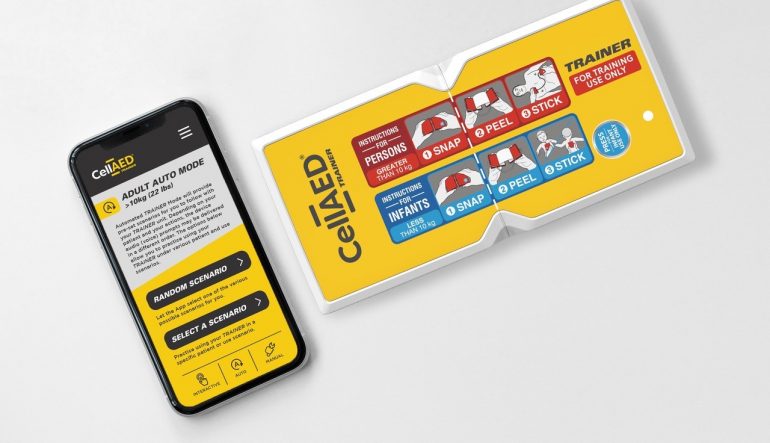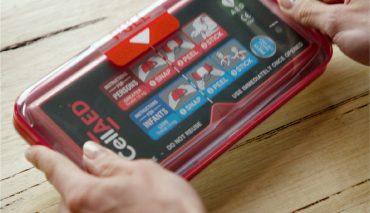CellAED TRAINERTM Learn. Practise. Repeat
There are many reasons why AEDs (automated external defibrillators) are not used in emergencies. As a result of these barriers, public access defibrillators are used in less than five per cent of all out-of-hospital cardiac arrests
Rapid Response Revival recently achieved CE Certification for its CellAED personal defibrillator, which was designed to address the many barriers to use of AEDs.
As efforts to secure regulatory approvals for CellAED® in other parts of the world continue, Rapid Response Revival is preparing to introduce a companion device to help people learn, practice and repeat application of CellAED®.
In this interview, Rapid Response Revival’s Head of Consumer Usability Research and Development, Dr Katherine Faull explains why CellAED TRAINERTM was developed, how it works, and what it is intended to achieve.
What is CellAED TRAINERTM
“CellAED TRAINERTM is a low-cost, reusable training version of the CellAED® personal defibrillator.
“Creating a training version of an AED isn’t a new idea. That said, we wanted to create an inexpensive simulator that can be used many times without the need for maintenance or replacement parts.”
Why was CellAED TRAINERTM created
“There were moments early in the development of CellAED® that prompted discussion around the need for a simulator.
“The key moment was during a usability study in 2019. We had just shown an instructional video explaining the CellAED® Snap Peel StickTM application method. Despite what our participants were shown on the video, some still hesitated in snapping the device to activate it.
“This got us thinking, is snap, peel, stick counter-intuitive? To address this, we made some CellAED® design changes – including the addition of V-notches marking the snap point – and started work on developing a separate training device.
“We also looked at studies into barriers to bystander intervention in out-of-hospital cardiac arrests.
“One of those barriers is lack of confidence to act, which can decrease significantly with appropriate training. Evidence has been replicated across multiple studies showing training increases use of AEDs and shortens the time it takes for a bystander to use an AED.
“Additional research showed that regular repetition of exposure embeds learning. In fact, when it comes to embedding skills and behaviours, regular repetition is more important to CPR and AED awareness training than the time since that training.
“This is why we designed CellAED TRAINERTM as a low-cost device that can be used over and over again.
“We’ve since introduced CellAED TRAINERTM to subsequent usability trials. We’ve found it effectively overcomes these barriers to act. We’ve also learned that no matter how easy we make CellAED® to apply, hesitation is significantly reduced if the user has had opportunity to practice with a Trainer first.”
What else did you learn during development of CellAED TRAINERTM
“When people realise how few critical steps are required to retrieve, activate and apply the Trainer, they realise just how much of a leap forward CellAED® represents for AEDs. The Trainer is an excellent demonstration of how useful CellAED® will be in an emergency.
“With CellAED® we’ve not only reduced the number of critical tasks to deploy the device – we’ve also made each of those tasks simple.
“There’s no need to connect electrode gel pads, or dialling up or down joules, for example.
“First Aid Trainers we’ve consulted in the development of CellAED® and CellAED TRAINERTM are excited by it. We’ve seen an even more emphatic response from laypersons.
“We weren’t expecting, for example, just how much an impact CellAED TRAINERTM has on prompting a desire in laypeople to learn about sudden cardiac arrest, and what they can do about it.
“CellAED TRAINERTM is such a simple tool, it also compels people to learn more about the problem CellAED® was designed to solve. It leaves people shocked at how little they know about sudden cardiac arrest, and wanting to remedy that – especially in terms of home use.”
RELATED ARTICLE: Knowing cardiac arrest when you see it
Who will use CellAED TRAINERTM
“Our initial idea was that CellAED TRAINERTM would appeal to people without CPR and AED training. What we’ve found since is that it’s also a great tool for people with CPR and AED training.
“CellAED® represents such a change to how AEDs are designed and applied, it can challenge people with traditional CPR training due to the extent of those changes.
“So, CellAED TRAINERTM is really for anyone who wants to prepare themselves or others to be ready to help someone survive a sudden cardiac arrest.”
How does CellAED TRAINERTM work
There are two elements to CellAED TRAINERTM – a physical device mimicking the design of the CellAED® personal defibrillator, paired with a CellAED TRAINERTM smartphone app.
The app allows training at the user’s own pace, with different scenarios representing real-life situations a CellAED® user may encounter. The audio cues built into the CellAED TRAINERTM app are the same as those that would be given by CellAED®.
“Combining a smartphone app with a physical device was a great way to keep costs down; we’ve managed to produce a simulator that is about a tenth of the cost of other AED trainers.
“Our training device allows people to Snap Peel StickTM as they would with the real device. The cable retracts easily to reset CellAED TRAINERTM and the simulation gel pads are very resilient. I have an early prototype that has been used dozens of times; the pads are still sticky and the cable still retracts quickly every time.
“For people who are CPR and AED aware, our hope is that CellAED TRAINERTM will help bridge the gap between how they think AEDs work, and what’s coming with CellAED®.
“The big opportunity however, is for CellAED TRAINERTM to keep encouraging people to learn more about sudden cardiac arrest, and how they can do something about it.”
DISCLAIMER: CellAED® is currently approved for use within the UK, European Economic Area, Australia and New Zealand. If you live outside these regions sign-up here to our newsletter where we will keep you updated and let you know when we launch into new countries.



